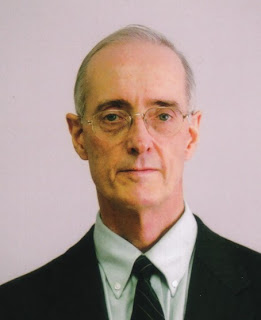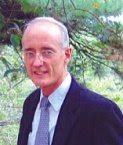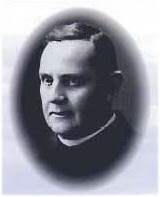The Spring 2008 edition of
Southeast Asia Program e-bulletin at Cornell University contained a very touching and personal tribute to
Fr. Roger Downey, S.J., former professor of Economics at Sophia University, by his thesis supervisor, Professor Erik Thorbecke. As this tribute revealed several dimensions of Roger that were unknown to many of his colleagues in Japan, I asked Professor Thorbecke for permission to post it in this blog, and he readily granted it. My sincere thanks to him and the editorial staff of the e-Bulletin for helping me get the permission.
************************************************************
Roger Downey
8 January 1944 - 26 December 2007
In Memoriam: Vignettes of his life

I first met Roger when he enrolled in the PhD. Program in Economics at Cornell University. Typically graduate students converge on a dissertation topic only in their third year in Graduate School. But not Roger. Almost as soon as he had arrived at Cornell he approached me to ask me to be his thesis supervisor and he proceeded to tell me in some detail what the topic of his thesis was going to be.He is the only graduate student - out of the approximately eighty I supervised - who knew even before embarking on the doctoral program what his specific research interest were. Of course, when Roger moved to Cornell he was already a mature scholar with a deep grounding in theology, philosophy and Asia. As a Jesuit he was very much concerned with issues related to poverty and income distribution and he had decided that in order to help alleviate poverty he needed to acquire a technical competence in economics and economic development. Perhaps even more surprising was the fact that he had selected Indonesia to be the focus of his dissertation research. He was planning to study the root causes of poverty and income inequality in Indonesia. Parallel to his economics studies he became fluent in Bahasa Indonesian and immersed himself in the rich activities of the Southeast Program at Cornell.
• • •
While a graduate student at Cornell, Roger lived in a Catholic parish about ten miles from campus where he assisted the priest- a very old and colorful Irishmanwith pastoral duties. On St Patrick day the Irish priest together with Roger would organize a party for the congregation to which we would be invited. Although Roger was always mindful of the need to maintain the right decorum, once he brought my wife over to an empty corner of the party room away from the crowd and proceeded to show her how proficient a dancer he was. He was careful that nobody would see him. Behind a serious exterior was hiding a “joie de vivre” always under control.
• • •
Close to the parish where Roger resided was a small lake with a row boat. One of Roger’s fellow graduate students at that time was Iwan Azis (today one of the leading Indonesian economists). Roger invited Iwan to row across the lake. When they reached the middle of the lake Iwan dropped his camera in the water and fell overboard. After a short while Roger realized that Iwan did not know how to swim and had to dive in the cold water to save Iwan’s life. (Incidentally Iwan who was also one of my students shares the same birthday as mine: February 17 which is also the date of the Memorial Mass in Roger’s honor. We shall think of him and pray for him on that day).
• • •
Just at about the time Roger had completed all of the course work for his PhD. and was ready to embark on writing his dissertation a very fortunate thing happened. The Dutch Ministry of Overseas Development was initiating a research and training program to help the Indonesian Statistical Bureau build a competence around the concept of the “Social Accounting Matrix” (SAM) that is crucial in understanding and measuring the inter-relationship among the structure of production, the incomes of different socio-economic groups, their consumption patterns and the satisfaction of basic needs. The SAM is a necessary quantitative and analytical tool to understand the root causes of poverty.
The Institute of Social Studies in the Netherlands approached me to see if I (as one of the earlier architects of the SAM) would be interested in joining force with the ISS in preparing a proposal to be submitted to the Ministry. I immediately contacted Roger who expressed great interest in being involved. The proposal called for a small team of experts to be located at the Indonesian Statistical Bureau in Jakarta first for a three year period and subsequently renewable. The proposal jointly submitted (ISS and Cornell) was funded and Roger became the chief of party of a small group of experts. In retrospect the timing could not have been better. Just at the time Roger was ready to work on the topic he had focused on years earlier and which led him to pursue an advanced degree in Economics, destiny intervened with a golden opportunity.
• • •
As co-technical director of this project one of my duties was to prepare a budget including settling on a salary for Roger. Since Roger’s lifestyle was very modest and frugal and since he was planning to live in the Jesuit complex in Jakarta I, naively, assumed that he would be satisfied with a likewise modest salary. To my great surprise Roger proved to be a hard nosed and demanding negotiator requesting the remuneration that he thought befitted the position. My first reaction was that this behavior was not in keeping with Roger’s character but then I realized that I was wrong and that he was fully entitled to the market salary.
It is only years later that I heard that most of Roger’s salary if not all of it went to build a school in a remote part of Indonesia. Needless to say I learned a valuable lesson and felt guilty about my lack of sensitivity.
• • •
A key member of the team of experts working with Roger was a very young and very bright Dutch econometrician Steven Keuning. At regular intervals I would visit the team in Jakarta and have extensive discussions with the Indonesian statisticians at the Bureau. It was clear that although the SAM was a novel and esoteric concept very difficult for many Indonesians to grasp, Roger and his team were highly respected and valued.

Roger was a most demanding taskmaster expecting perfection from himself (more on this later) and from his co-workers. Often Steven would be frustrated by Roger’s expectations but, in the process, he and others would learn and acquire the enormous discipline, commitment to hard work and patience required to deal with large scale date sets originating from often mutually inconsistent sources. Steven Keuning has had a brilliant career and is now the Chief Statistician for the European Central Bank- a most prestigious job. I can not, of course speak for Steven but I feel confident that his professional success in improving, promoting and disseminating the SAM world-wide owes a debt of gratitude to Roger’s at times tormenting demands. Likewise, the Indonesian statisticians and economists who were trained under the auspices of this project have the highest appreciation for what they learned from Roger, Steven and their successors. The SAM project lasted about ten years and propelled Indonesia as the leading producer of SAMs globally.
• • •
After spending a number of years in Indonesia, it became time for Roger to return to Cornell to complete his PhD dissertation. On the basis of the progress already achieved and the chapters that I had read I had estimated that Roger would easily be able to finish his dissertation in a couple of semesters. Roger and I would have bi-weekly meetings to go over his work. He always insisted that we go into the material very thoroughly and in its most minute details. Time after time, as his supervisor I was satisfied with his work but he was not. Time went on and the thesis got longer and longer- reaching over 700 pages in length (the average length of a dissertation in Economics is probably around 200 pages). I finally put my foot down and told Roger that his dissertation met the most stringent quality requirements and that he should put an end to it. Roger refused. It did not meet his standards and he insisted on proceeding. I may be stubborn but I simply could not compete with Roger’s stubbornness.
• • •
When it appeared that we were at a standstill and that Roger would continue indefinitely to refine his dissertation, destiny again intervened. His Jesuit superiors ordered him to move to a new assignment (as I recall in the Philippines). Where I had failed his order succeeded. Roger felt very frustrated but with no choice in the matter he let go of his dissertation- quite unsatisfied with it- and promptly was rewarded with the prize for the best dissertation on Southeast Asia (in all disciplines) at Cornell. Roger was such a perfectionist that nothing he wrote (and probably others as well) was ever good enough. This is undoubtedly the reason he, as a first class and mature scholar, published relatively little in his lifetime. However his influence on others is continuing to be strong and enlightening through what he taught those fortunate enough to have crossed his path during his (too) short but rich and intensive lifetime.
• • •
Erik Thorbecke, Fort Bragg, CA, February 13, 2008
First published in
South Asia Program e-Bulletin at Cornell University








